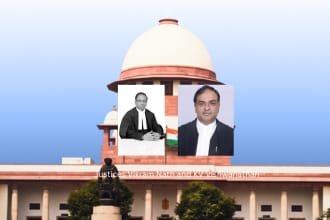In a major development in a contempt case that stirred widespread debate over free speech and judicial dignity, the Supreme Court of India has stayed a Bombay High Court order sentencing Vineeta Srinandan to one week in jail for criminal contempt. Srinandan, a Navi Mumbai resident and former cultural head of Seawoods Estates Limited, had circulated a controversial circular accusing certain judges of being part of a so-called “dog mafia” for allegedly supporting stray dog feeders.
The apex court’s interim relief came in the case Vineeta Srinandan vs. High Court of Judicature at Bombay on its own motion, offering the petitioner a crucial reprieve and opening the door to broader questions surrounding judicial criticism, contempt powers, and freedom of expression.
Background: The Circular That Sparked Contempt Proceedings
The contempt proceedings originated from a circular issued by Srinandan on January 29, 2024, amid tensions between residents of Seawoods Estates Limited and individuals who regularly fed stray dogs on the premises. The Bombay High Court had earlier ruled against the housing society’s attempt to restrict access to a house help who was among the dog feeders.
Following this judgment, Srinandan circulated a letter among over 1,500 residents, alleging that dog feeders were being protected by the judiciary and insinuating that a “dog mafia” existed within the legal system.
“Now we are convinced that there is a big Dog mafia operating in the country, who has a list of High Court and Supreme Court judges having views similar to the dog feeders,” her circular stated.
The tone and content of this circular caught the attention of the Bombay High Court, which initiated suo motu criminal contempt proceedings against her, viewing the letter as an attack on the judiciary’s integrity.
Bombay High Court’s Conviction and Sentencing
In its April 23, 2025 judgment, the Bombay High Court held that Srinandan’s comments:
- Scandalised the court
- Lowered the authority of the judiciary
- Undermined public confidence in judicial processes
Rejecting her written apology, the Court concluded it lacked genuine remorse and called it a mere tactical defence. Consequently, Srinandan was sentenced to one week of imprisonment and a fine of ₹2,000.
“It cannot be believed that when the contemnor undertook such contumacious writing, she was not conscious or could be said to be unaware of the consequences,” the High Court observed.
Supreme Court’s Intervention: Interim Stay on Arrest and Sentence
Srinandan, represented by Senior Advocate Dama Seshadri Naidu and a legal team comprising Yash S. Vijay, Pranjal Agarwal, Dixita Gohil, KMS Sivani, Anisha Mahajan, Deepak Sharma, and Shikhar Aggarwal, moved the Supreme Court against her conviction.
A Bench of Justices Vikram Nath and KV Viswanathan heard the matter on May 1, 2025, and issued a notice to the State, while staying her arrest and the High Court’s punishment order. This stay is in effect pending further hearings on the matter.
Judicial Balance: Free Speech vs. Contempt
The case raises pivotal legal and constitutional questions:
- Can citizens criticize the judiciary in private or semi-private settings without facing contempt?
- What distinguishes legitimate criticism from criminal contempt under Article 129 and Article 215 of the Constitution?
- Should intent and remorse play a greater role in contempt sentencing?
While free speech is protected under Article 19(1)(a) of the Constitution, it is subject to reasonable restrictions. However, courts have repeatedly stressed that criticism of judgments—even if harsh—does not automatically constitute contempt unless it lowers the authority of the court or impairs administration of justice.
In this case, the High Court viewed Srinandan’s circular as a direct affront to judicial impartiality, while her defence is likely to argue that it was a personal opinion shared in a housing society context, without intent to malign the judiciary.
Significance of the Supreme Court’s Order
The stay granted by Justices Vikram Nath and KV Viswanathan is significant on multiple levels:
- It prevents immediate incarceration of the petitioner, allowing her legal challenge to proceed without prejudice.
- It signals the Supreme Court’s willingness to examine whether the High Court may have overreached in punishing personal expressions as contempt.
- It reflects the evolving judicial approach to contempt jurisprudence, particularly in the context of citizen dissent and criticism.
Contempt of Court: A Legal Overview
Contempt of court, especially criminal contempt, is defined under the Contempt of Courts Act, 1971 as any act that:
- Scandalizes or tends to scandalize any court
- Prejudices or interferes with judicial proceedings
- Obstructs the administration of justice
However, Indian courts have often had to walk a tightrope between protecting their dignity and not stifling free speech. Landmark cases such as:
- P.N. Duda v. P. Shiv Shankar (1988)
- Arundhati Roy Contempt Case (2002)
- Prashant Bhushan Case (2020)
have all showcased how courts respond to critiques from public figures and citizens, balancing judicial authority with democratic freedoms.
Broader Implications for Civic Discourse
This case also underscores the growing friction between citizen activism, animal rights issues, and legal interpretations. Conflicts around stray dog feeding in urban India have increasingly made their way to courts, often resulting in emotionally charged debates and litigation.
As such issues gain traction, the judiciary’s response to public commentary—even if sharp or poorly worded—needs to be both principled and proportional.
Conclusion
The Supreme Court’s interim stay on Vineeta Srinandan’s conviction for criminal contempt offers her a lifeline and sets the stage for a crucial legal battle. As the top court now examines whether her statements, made in a housing society circular, amount to contempt or are protected by free speech, the outcome will have important consequences for how criticism of the judiciary is treated in India.
In the days ahead, this case will be closely watched—not just for its legal implications, but also for what it says about the limits of expression, the scope of judicial accountability, and the role of the courts in a democracy.



